Views
Change the view title
To change the title of the view, in a .module file, you can use this code:
function views_play_views_pre_view(\Drupal\views\ViewExecutable $view, $display_id, array $args) {
// Check if the view is the one we want to alter.
if ($view->id() === 'blurbs' && $display_id === 'page_1') {
$user = \Drupal::currentUser();
if ($user->hasRole('administrator')) {
// Returns a Drupal\views\Plugin\views\display\Page object for a page view.
$display = $view->getDisplay();
$display->setOption('title', 'Hello, Administrator!');
}
}
}Change contextual filters value
Assuming the URL https://ddev102.ddev.site/blurbs/green where green is the value you are passing to the contextual filter, you could change it to use red with the following code:
/**
* Implements hook_views_pre_view().
*
*/
function views_play_views_pre_view(\Drupal\views\ViewExecutable $view, $display_id, array $args) {
// Check if the view is the one we want to alter.
if ($view->id() === 'blurbs' && $display_id === 'page_1') {
$args[0] = 'red';
$view->setArguments($args);
}
}Disable an exposed filter
Assuming you have an exposed filter on a reference field called field_section you want to remove the dropdown select list, you can use hook_views_pre_view() to do the job:
/**
* Implements hook_views_pre_view().
*
*/
function views_play_views_pre_view(\Drupal\views\ViewExecutable $view, $display_id, array $args) {
// Check if the view is the one we want to alter.
if ($view->id() === 'blurbs' && $display_id === 'page_1') {
$filters = $view->getDisplay()->getOption('filters');
// Disable exposed filter.
$filters['field_section_target_id']['exposed'] = FALSE;
$display->setOption('filters', $filters);
}
}Change a filter
Assuming you have a filter on a list field called field_traffic_light and you want to change the value of the filter to include both red and green, you can use hook_views_pre_view() to do the job:
/**
* Implements hook_views_pre_view().
*
*/
function views_play_views_pre_view(\Drupal\views\ViewExecutable $view, $display_id, array $args) {
// Check if the view is the one we want to alter.
if ($view->id() === 'blurbs' && $display_id === 'page_1') {
// Change a filter.
$display = $view->getDisplay();
$filters = $view->getDisplay()->getOption('filters');
$filters['field_traffic_light_value']['value'] = ['red', 'green'];
$display->setOption('filters', $filters); }
}Views cleverly names the array according to whether the field is a reference field or some other value field by using names like field_section_target_id and field_traffic_light_value, respectively.
Add a filter
Using hook_views_pre_view() you can retrieve the current filters, define a new one in an array and add it to the filters array. This example adds a filter for a taxonomy term field called field_topics_target_id which is for a taxonomy reference field. Note that the key and the id can be anything you want. Views uses a naming convention like field_section_target_id and field_traffic_light_value when it generates them:
/**
* Implements hook_views_pre_view().
*
*/
function views_play_views_pre_view(\Drupal\views\ViewExecutable $view, $display_id, array $args) {
$display = $view->getDisplay();
$filters = $view->getDisplay()->getOption('filters');
$new_filter = [
'tid' => [ // Views will use 'field_topics_target_id'
'id' => 'tid', //Views will use 'field_topics_target_id'
'table' => 'node__field_topics',
'field' => 'field_topics_target_id',
'relationship' => 'none',
'group_type' => 'group',
'admin_label' => '',
'plugin_id' => 'taxonomy_index_tid',
'operator' => 'or',
'value' => $value,
'group' => 1,
'exposed' => FALSE,
'expose' => [], //..13 element array
'is_grouped' => FALSE,
'group_info' => [], //..10 element array
'reduce_duplicates' => FALSE,
'vid' => 'topics',
'type' => 'select',
'hierarchy' => FALSE,
'limit' => TRUE,
'error_message' => TRUE,
],
];
$filters = $filter + $new_filter;
$display->setOption('filters', $filters);
}Template Preprocess views view
Using template_preprocess_views_view you customize the view by adding or modifying variables. This is useful if you want to add a form or some other variable to the view. See more at the Drupal API link to function template_preprocess_views_view
Example 1
This is used in a custom module at /Users/selwyn/Sites/dir/web/modules/custom/dir/dir.module. It adds a form EventsByMonthForm which can be displayed on the view using the TWIG template. In the code, the view and display are identified and the $variables['events_by_month'] is added.
/**
* Implements template_preprocess_views_view().
*/
function dirt_preprocess_views_view(&$variables) {
$view = $variables['view'];
$view_name = $view->storage->id();
$display_id = $view->current_display;
if ($view_name == 'events_for_events_landing_page' && $display_id == 'upcoming') {
$variables['events_by_month'] = \Drupal::formBuilder()->getForm('Drupal\dir\Form\EventsByMonthForm');
}
}Example 2
This is a barebones example of how to modify a view using the template_preprocess_views_view() function. This would be stored in a custom module or .theme file. It modifies the view events by looping through the results and modifying each row as needed.
function dirt_preprocess_views_view(array &$variables) {
$view = $variables['view'];
// Check if this is a specific view.
if ($view->name == 'events') {
foreach ($view->result as $r => $result) {
// Modify each "row" as needed.
// For example, you can access fields like $result->field_name.
// Add your custom logic here.
}
}
// You can handle other views here if needed.
}Example 3
This version looks up the venue reference field and replaces the node ID with the venue reference field's title.
function dirt_preprocess_views_view(array &$variables) {
$view = $variables['view'];
if ($view->id() == 'events_landing_page') {
foreach ($view->result as $r => $result) {
$node = $result->_entity;
$venue = $node->get('field_venue')->entity;
// Replace the node ID with the venue reference field's title.
// I know this looks a little weird but it just replaces the id() field in the view with the venue reference field's title.
$variables['rows'][$r]['#row']->nid = $venue->getTitle();
}
}
// You can handle other views here if needed.
}Template Preprocess Views View Field
This is used to replace a field in a view. Here is a quick example:
Example 1
function uswds_abc_preprocess_views_view_field(&$variables) {
$view = $variables['view'];
$view_name = $view->id();
$field = $variables['field'];
$field_name = $field->field;
$display = $view->current_display;
if ($view_name == 'per_table' &&
$display == 'per_table_auto' &&
$field_name == 'field_name') {
$variables['output'] = 'News output';
}
// The nothing field is a placeholder custom text field.
if ($view_name === 'toolkit' && $field_name === 'nothing') {
$variables['output'] = 'Your custom value here';
}
}Example 2
This function from /Users/selwyn/Sites/txglobal/web/themes/custom/txglobal/txglobal.theme modifies the value of the nid field in the news_events_search view. It does some magic based on the nid field which is in the view and builds some stuff
/**
* Implements template_preprocess_views_view_field().
*/
function txglobal_preprocess_views_view_field(&$variables) {
$view = $variables["view"];
$viewname = $view->id();
$display = $variables["view"]->current_display;
if ($viewname == 'news_events_search' && $display == 'page_events') {
$field = $variables['field']->field;
if ($field == 'nid') {
$nid = $variables['output'];
if ($nid) {
$nid = $nid->__toString(); // Uh, it’s a Drupal render markup object- need string.
$node = Node::load($nid);
$node_type = $node->getType();
$aofs = _txglobal_multival_ref_data($node->field_ref_aof, 'aof', 'target_id');
$units = _txglobal_multival_ref_data($node->field_ref_unit, 'unit', 'target_id');
..
$related_items = array_merge($topics, $aofs, $units,$countries);
// New variable that will be readable in TWIG file
$variables['related_items'] = $related_items;
// Build a UL with a bunch of LI links in it
$links = '<ul>';
foreach ($related_items as $item) {
$links = $links . '<li><a href="/events/search?' . $item['param_name'] . '=' . $item['id'] . '">' . $item['title'] . '</a></li>';
}
$links .= '</ul>';
// Modify the actual output
// This outputs only text, not HTML so...
$variables['output'] = $links;
// Render it so you get legit HTML
$variables['output'] = \Drupal\Core\Render\Markup::create($links);
// OR add new variable that will be readable in TWIG file
$variables['related_items'] = \Drupal\Core\Render\Markup::create($links);
}
}
}
}Also of note here: To output the new variable put that in the twig file e.g. views-view-field--news-events-search--page-nid.html.twig (as in /Users/selwyn/Sites/txglobal/web/themes/custom/txglobal/templates/views/views-view--news-events-search--page-events.html.twig). The variable is output like this:
{{ related_items }}For completeness, here is the function that retrieves the values from the node and builds the array of related items.
/**
* Returns array of data for multivalue node reference fields.
*
* @param \Drupal\Core\Field\FieldItemListInterface $ref_field
* The entity reference field which we are building the links from.
* @param string $param_name
* Parameter name to be passed as get value.
* @param string $value_type
* Indicates which field to retrieve from database.
* @param string $field_ref_type
* Variable to determine type of reference field.
*
* @return array
* Array of data.
*
* @throws \Drupal\Component\Plugin\Exception\InvalidPluginDefinitionException
* @throws \Drupal\Component\Plugin\Exception\PluginNotFoundException
*/
function _txglobal_multival_ref_data(FieldItemListInterface $ref_field, $param_name, $value_type, $field_ref_type = 'node') {
$values = [];
$title = '';
if ($ref_field) {
foreach ($ref_field as $ref) {
if ($field_ref_type == 'taxonomy') {
$term = Drupal::entityTypeManager()
->getStorage('taxonomy_term')
->load($ref->$value_type);
if ($term) {
$title = $term->getName();
}
}
else {
if ($value_type == 'value') {
$title = $ref->$value_type;
}
else {
if (isset($ref->entity->title->value)) {
$title = $ref->entity->title->value;
}
}
}
$id = $ref->$value_type;
$values[] = [
'title' => $title,
'id' => str_replace(' ', '+', $id),
'param_name' => $param_name,
];
}
}
return $values;
}Example 3
Another version of ~/Sites/txglobal/web/themes/custom/txglobal/txglobal.theme which builds a UL of links based on the nid field in the view. It also uses a helper function to build the links. The helper function is in the same file and is called build_related_items_links().
/**
* Implements template_preprocess_views_view_field().
*
* This function replaces the nid field in the view with
* a UL of links.
*/
function txglobal_preprocess_views_view_field(&$variables) {
$view = $variables["view"];
$viewname = $view->id();
$display = $variables["view"]->current_display;
$displays = ['page_events', 'block_1', 'audience', 'program', 'unit'];
if ($viewname == 'news_events_search' || $viewname == 'events_for_this_anything') {
if (in_array($display, $displays)) {
$field = $variables['field']->field;
if ($field == 'nid') {
$nid = $variables['output'];
if ($nid) {
$nid = $nid->__toString();
$nid = intval($nid);
$node = Node::load($nid);
$related_items = build_related_items_links($node);
// Build the UL of related links.
$links = '<ul class="categories-block no-bullet">';
foreach ($related_items as $item) {
$links = $links . '<li><a href="/events/search?' . $item['param_name'] . '=' . $item['id'] . '">' . $item['title'] . '</a></li>';
}
$links .= '</ul>';
// Render it so you get legit HTML.
$variables['output'] = Markup::create($links);
}
}
}
}
}Here is the helper function that builds the links:
function build_related_items_links(Node $node) {
$node_type = $node->getType();
$collections = [];
$programs = [];
$topics = [];
$aofs = [];
$units = [];
$audiences = [];
$continents = [];
$countries = [];
if ($node->hasField('field_ref_aof')) {
$aofs = $node->field_ref_aof->target_id ? _txglobal_multival_ref_data($node->field_ref_aof, 'aof', 'target_id') : [];
}
if ($node->hasField('field_ref_unit')) {
$units = NULL !== $node->field_ref_unit->target_id ? _txglobal_multival_ref_data($node->field_ref_unit, 'unit', 'target_id') : [];
}
if ($node->hasField('field_ref_audience')) {
$audiences = NULL !== $node->field_ref_audience->target_id ? _txglobal_multival_ref_data($node->field_ref_audience, 'audience', 'target_id') : [];
}
if ($node->hasField('field_continent')) {
$continents = NULL !== $node->field_continent->value ? _txglobal_multival_ref_data($node->field_continent, 'continent', 'value', 'list') : [];
}
if ($node->hasField('field_ref_country')) {
$countries = NULL !== $node->field_ref_country->target_id ? _txglobal_multival_ref_data($node->field_ref_country, 'country', 'target_id') : [];
}
if ($node->hasField('field_ref_programs')) {
$programs = NULL !== $node->field_ref_programs->target_id ? _txglobal_multival_ref_data($node->field_ref_programs, 'program', 'target_id') : [];
}
if ($node->hasField('field_ref_program_collection')) {
$collections = NULL !== $node->field_ref_program_collection->target_id ? _txglobal_multival_ref_data($node->field_ref_program_collection, 'collection', 'target_id') : [];
}
if ($node->hasField('field_ref_topic')) {
$topics = NULL !== $node->field_ref_topic->target_id ? _txglobal_multival_ref_data($node->field_ref_topic, 'topic', 'target_id', 'taxonomy') : [];
}
$related_items = array_merge($topics, $aofs, $units, $audiences, $collections, $programs, $continents, $countries);
return $related_items;
}And the template
{%
set classes = [
dom_id ? 'js-view-dom-id-' ~ dom_id,
]
%}
<section class="content-section filter-search-form-section">
{{ title_prefix }}
{{ title }}
{{ title_suffix }}
{% set searchType = 'Events' %}
{% include '@txglobal/partials/searchfilterform.html.twig' %}
{% if header %}
<header>
{{ header }}
</header>
{% endif %}
{{ exposed }}
{{ attachment_before }}
<div class="grid-container">
<div class="grid-x grid-margin-x">
{% if rows -%}
{{ rows }}
{% elseif empty -%}
<div class="cell">
{{ empty }}
</div>
{% endif %}
{% if pager %}
<div class="cell small-12">
{{ pager }}
</div>
{% endif %}
</div>
</div>
{{ attachment_after }}
{{ more }}
{% if footer %}
<footer>
{{ footer }}
</footer>
{% endif %}
{{ feed_icons }}
</section>Example 4
This example has a view called selwyntest3 and a display called page_1. It modifies the nid field to output a specific value. In this case, there were two nid fields. Views refers to them as nid and nid_1. This shows how to find the correct field and modify the output. It is from ~/Sites/tea/docroot/themes/custom/tea/tea.theme.
function tea_preprocess_views_view_field(&$variables) {
$view = $variables['view'];
$view_name = $view->id();
$display_name = $view->current_display;
if ($view_name == 'selwyntest3' && $display_name == 'page_1') {
$field_name = $variables['field']->field;
if ($field_name == 'nid') {
/** @var Drupal\views\Plugin\views\field\EntityField $entity_field */
$entity_field = $variables['field'];
/** @var Drupal\Component\Plugin\Definition\PluginDefinition $plugin */
//$plugin = $entity_field->getPluginDefinition();
$options = $entity_field->options;
$view_field_machine_name = $options['id'];
if ($views_field_machine_name == 'nid_1') {
$program_nid = '825601';
$variables['output'] = $program_nid;
}
}
}
}Example 5
This example from my_module.module file modifies the output of the type field in the search view. It replaces the value in the type field with the bundle for a content type or custom entity (and formats it slightly).
/**
* Implements template_preprocess_views_view_field().
*/
function my_module_preprocess_views_view_field(array &$variables) {
$view = $variables["view"];
$viewname = $view->id();
$display = $variables["view"]->current_display;
if ($viewname == 'search' && $display == 'block_1') {
$field = $variables['field']->field;
if ($field == 'type') {
if (\Drupal::currentUser()->isAnonymous()) {
$entity = $variables['row']->_entity;
$bundle = $entity->bundle();
$type = $entity->getEntityType()->id();
// Append `document` to the bundle name if the type is `www_document`.
if ($type == 'www_document' && str_contains($bundle, 'document') === false) {
$bundle .= ' Document';
}
// Convert to title case.
$bundle = ucwords($bundle);
$variables['output'] = \Drupal\Core\Render\Markup::create($bundle);
}
}
}
}Either Or in views
This is such a neat trick to show one field if it exists otherwise show another field:
- Add a field for
field1and exclude it from display. - Add a field for
field2and exclude it from display. - Add a third field for
field2again - In the rewrite results, put the token for
field2. Eg.[colorbox] - In the
No results behavior, put the token forfield1e.g.[field1].
This is the equivalent of an if then else statement in views.
Views Query options
When views give you unexpected results that seem permissions-related, you can check the query options. This is a screenshot of the query options for a view. You can see the query options by clicking on the Advanced link in the view and then in the other section, click on Query settings. Sometimes it is useful to disable SQL rewriting as this bypasses security and returns the same data that you get as when you are logged in as user 1.
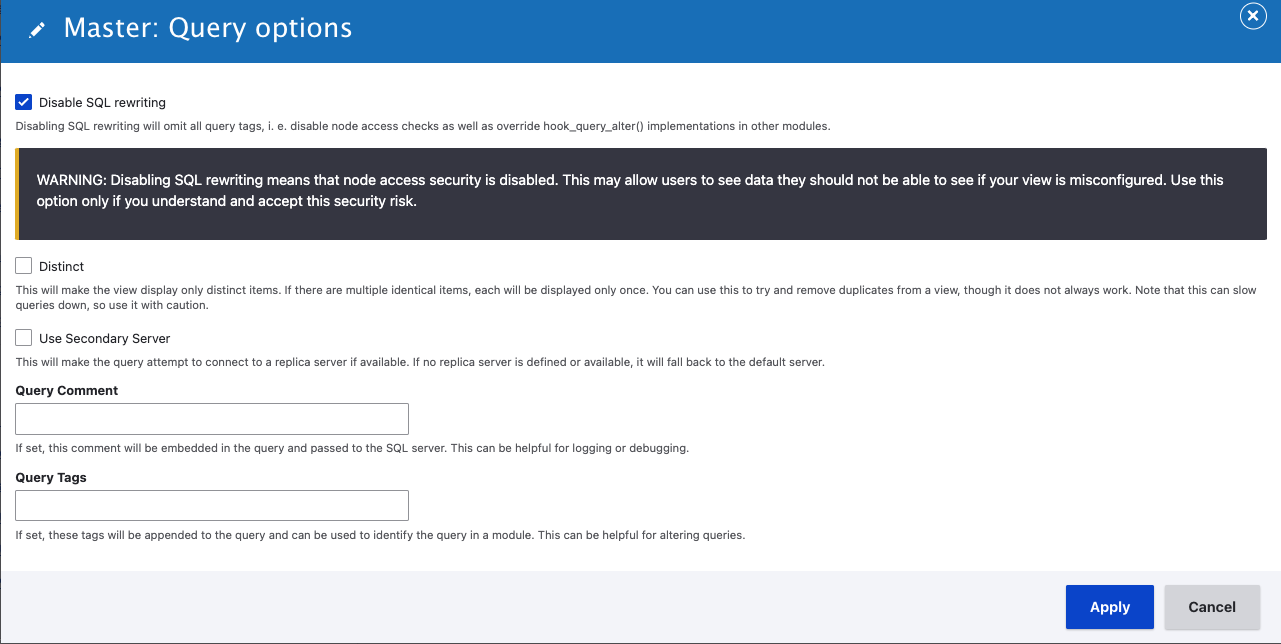
Note
The dialog will display this WARNING: Disabling SQL rewriting means that node access security is disabled. This may allow users to see data they should not be able to see if your view is misconfigured. Use this option only if you understand and accept this security risk.
Jump Menu
Using the Views Jump Menu module you can easily create a node-driven no-code drop-down select box. The instructions are a bit confusing.
After installing (composer require 'drupal/views_jump_menu:^1.0@RC') and enabling the module, create a content type (e.g. jump_items) with a plain text field for a URL. Don't use a link field. Create some jump_items nodes. e.g.
- Apple https://www.apple.com
- Microsoft https://www.microsoft.com
- Google https://www.google.com
- Node 10 /node/10
Note
You can use external or internal URLs as in the example above, where we used a relative URL /node/10
Create a view jump1. Add a block with a format of Jump Menu.
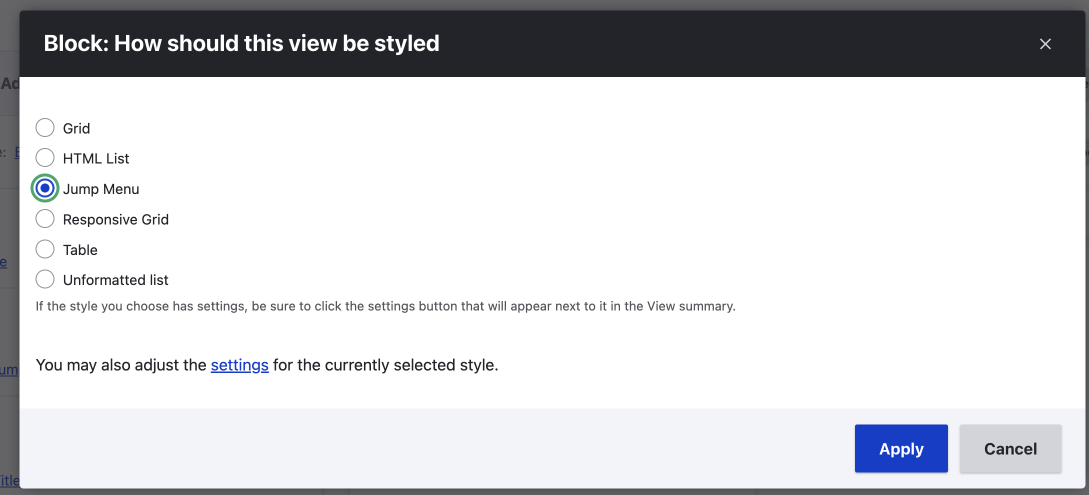
Add the fields that will be used for the jump menu. I used title field and link2 field.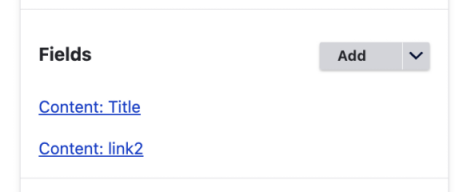
For the block format jump menu settings: 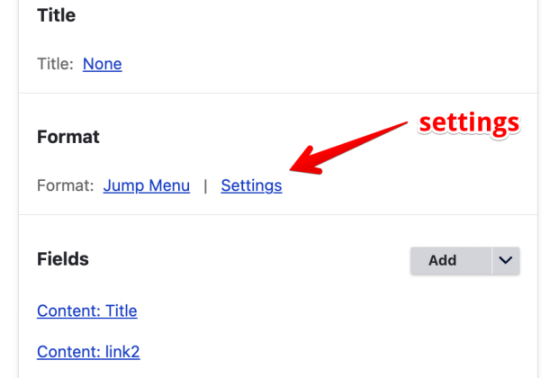
specify the label field and URL field. Use the title and link2 fields respectively. 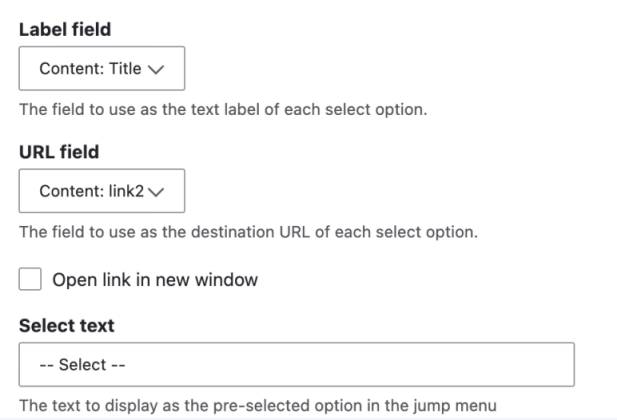
Now set the block to display where you want it and voila! The drop-down select field will appear in its block, and you can select it, and it will immediately load the associated page.
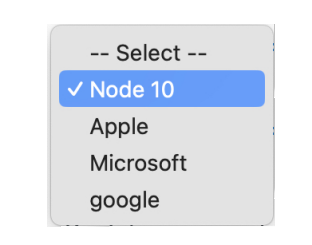
Search multiple fields with a single search box
This core functionality allows a view to have an exposed filter that searches multiple fields for a given search term. It essentially allows you to combine multiple exposed search filters into a single search box.
To set it up, include all the fields that you want to search in the Fields section, marking them with Exclude from display as necessary. Then, add and expose a Combine fields filter to the view, and configure it to use all the fields you want searchable in the Choose fields to combine for filtering section of the filter's configuration
Thanks to Mike Anello's blog post outlining this useful feature.
See Views Query
To see the query that views generates, use the following code:
use Drupal\views\ViewExecutable;
/**
* Implements hook_views_post_execute().
*/
function MY_MODULE_views_post_execute(ViewExecutable $view) {
$channel = 'view_query:' . $view->id();
$message = $view->query->query();
\Drupal::logger($channel)->debug($message);
}From Goran Nikolovski blog post How to see your Drupal Views query - Mar 2024
Alternatively, you could add this code to your theme's THEME.theme file. This will output the query to the screen.
function THEME_views_pre_execute(\Drupal\views\ViewExecutable $view) {
$query = $view->query;
$query_string = (string) $query;
\Drupal::logger('THEME')->notice($query_string);
}Set the title for a view programmatically
Here is some code that gets the views arguments and sets the title based on the argument. This is from a custom module. The view is called loaders and the display is loaders_list_block. The title is set to the state abbreviation. If the argument is the same as the exception value, the title is not set.
/**
* Implements hook_views_pre_render().
*/
function my_module_views_pre_render(ViewExecutable $view) {
$view_id = $view->id();
switch ($view_id) {
///...
case 'loaders':
// Check the display.
if ($view->current_display !== 'loaders_list_block') {
break;
}
$title = $view->getTitle();
$view_args = $view->args;
if (is_array($view_args)) {
$state_arg = $view_args[0];
if ($state_arg == $view->argument['field_acronym_value_1']->options['exception']['value']) {
break;
}
$view->setTitle($title . ' for ' . _get_taxonomy_term_by_abbreviation($state_arg));
}
break;
}
// For completeness, here is the helper function that retrieves the taxonomy term by abbreviation.
function _get_taxonomy_term_by_abbreviation(?string $abbreviation): string {
if (is_null($abbreviation) || empty($abbreviation) {
return '';
}
$entity_query = \Drupal::entityTypeManager()->getStorage('taxonomy_term')->getQuery()->accessCheck(FALSE);
$entity_result = $entity_query->condition('vid', 'states_and_territories')
->condition('field_acronym', $abbreviation)
->execute();
if (empty($entity_result)) {
return '';
}
$term_entity = \Drupal::entityTypeManager()->getStorage('taxonomy_term')->load(array_pop($entity_result));
return $term_entity?->label() ?? '';
}Exclude previously loaded nodes from a view
Using the Views exclude previous module you can exclude previously loaded nodes from a view. This is useful when you have a view and an attachment view but you don't want them to both show the same nodes. It provides a filter that you can add to the view to exclude previously loaded nodes.
Display a list of content that has values in paragraph titles
In this case, I have content types that have paragraphs that are put into a field_content field. (Sorry, I know that is a confusing name for a field). The paragraphs have a field_title field. I want to display a list of content that has paragraphs with titles that contain 'Resources', 'Tools' or 'Software' in field_title.
First, I have to establish a relationship between the field field_content in the node and the paragraphs it references. When I click add relationships each field that allows paragraphs is listed e.g. Paragraph referenced from field_xxxx. I chose the Paragraph referenced from field_content.
I can filter by paragraph types by adding a paragraph type filter. This is listed as Paragraph type. In the screenshot below, I chose some types. I can specify the relationship to use as field_content: Paragraph (if there is only 1, this is the default). This shows up in the view as (field_content: Paragraph) Paragraph type (in Lab Cus...).
For filtering the field_content, I add those filters and specify contains Resources, contains tools and contains software and specify the relationship as (field_content: Paragraph). This shows up as (field_content: Paragraph) Title Override (contains Resources).
I also used the add/or rearrange filter criteria to break the filters into groups and specify some or conditions.
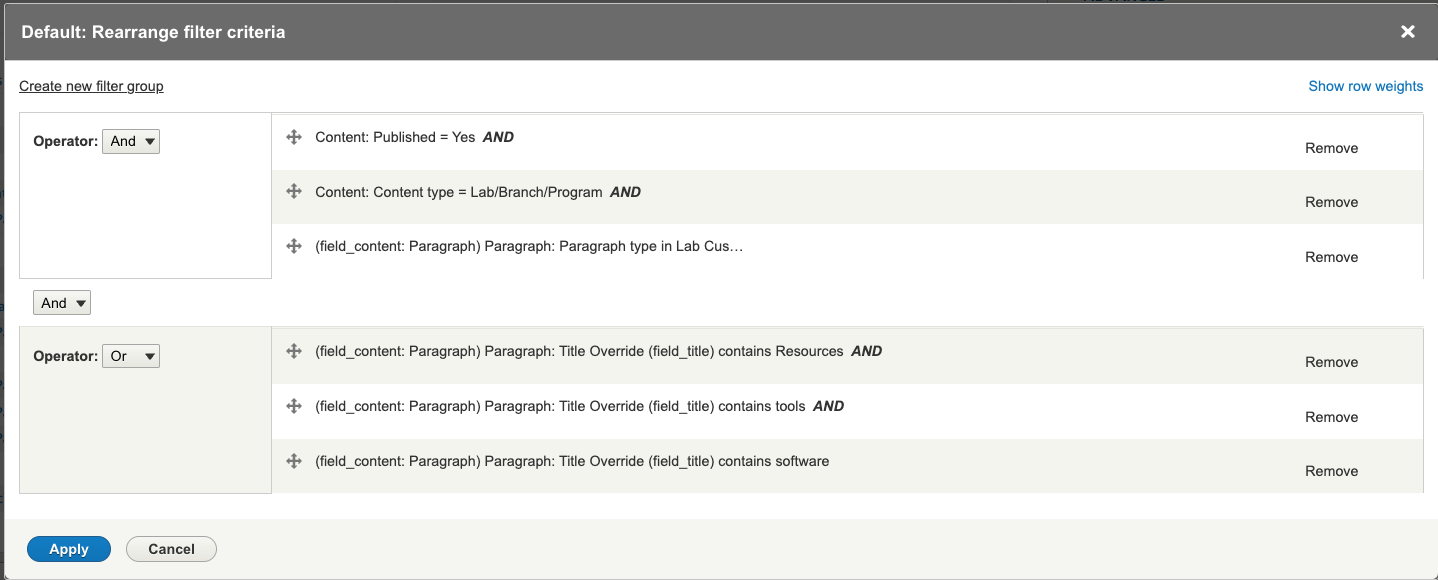
See the image below for what the view looks like: 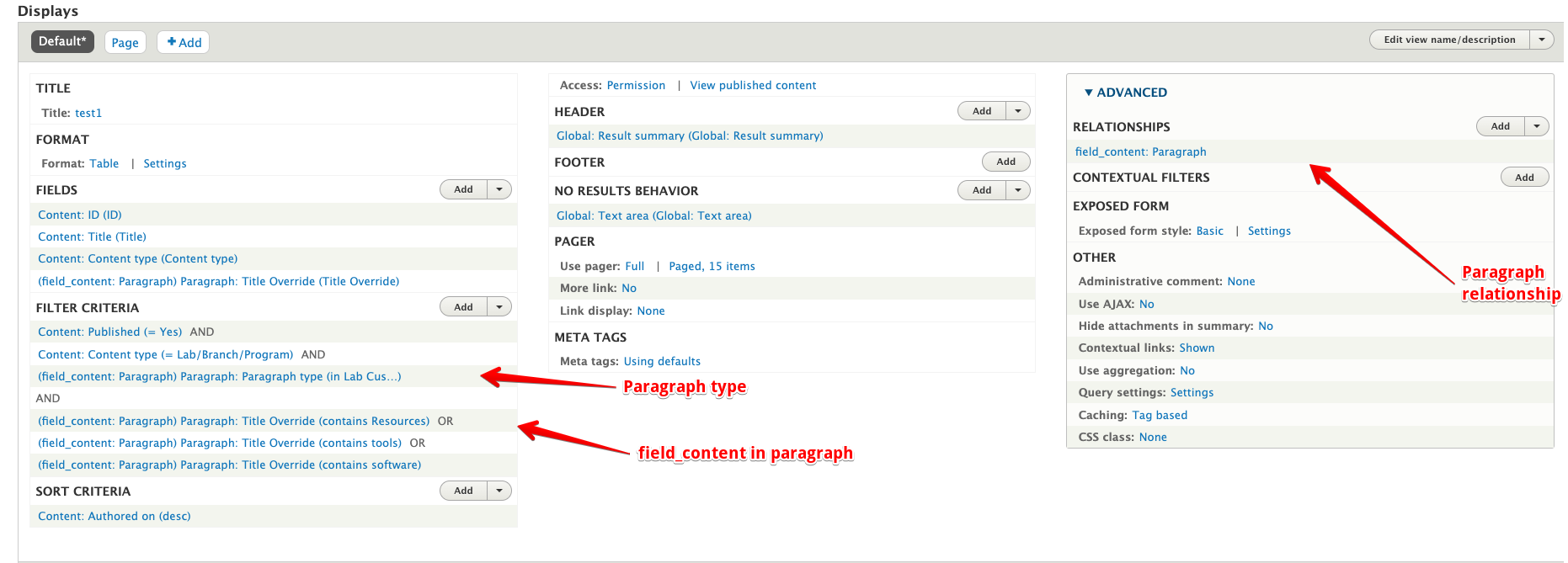
Reference
Views API
Look in core/modules/views/views.api.php for all the hooks available for views, along with examples of their usage. The file is also available online at Drupal API Reference: views.api.php
hook_views_pre_view()
In Drupal API Reference: hooks_views_pre_view you can make significant changes to a view before it appears on a page. These include:
- Alter a view at the very beginning of Views processing.
- Add an attached view to the view by setting
$view->attachment_beforeand$view->attachment_after.
Note
To make the changes appear on the page, you will notify the $view object or the display object using calls like: $view->setArguments($args) or $view->setOption('title', $new_title). The $view object is passed as an argument, but you will have to retrieve the display object using $display = $view->getDisplay().
For example, to add an argument (contextual filter value) use this code in a .module file:
function hook_views_pre_view(ViewExecutable $view, $display_id, array &$args) {
// Modify contextual filters for my_special_view if user has 'my special permission'.
$account = \Drupal::currentUser();
if ($view->id() == 'my_special_view' && $account->hasPermission('my special permission') && $display_id == 'public_display') {
$args[0] = 'custom value';
$view->setArguments($args);
}
}To change the title of the view, in a '.module' file, you can use this code:
function views_play_views_pre_view(\Drupal\views\ViewExecutable $view, $display_id, array $args) {
// Check if the view is the one we want to alter.
if ($view->id() === 'blurbs' && $display_id === 'page_1') {
$user = \Drupal::currentUser();
if ($user->hasRole('administrator')) {
// Returns a Drupal\views\Plugin\views\display\Page object for a page view.
$display = $view->getDisplay();
$display->setOption('title', 'Hello, Administrator!');
}
}
}To make changes to filters in a view, retrieve the filters with $filters = $view->getDisplay()->getOption('filters'). This returns an array with an element corresponding to each filter defined in the view. So the view with these filters defined:
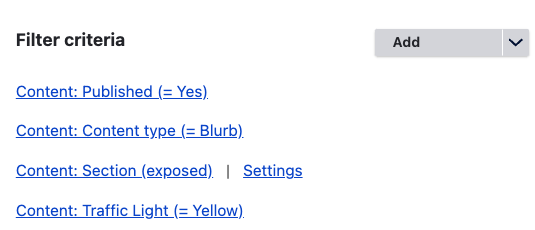
Will return an array like this:

You can modify the filters array and set that back into the view for processing with $display->setOption('filters', $filters).
Attached views
If you need to make changes to the attached views, this is the technique you can use to retrieve them. This code is from a .module file. It retrieves the attached views and returns the matching one if it is found.
function _get_attachments(ViewExecutable $view, string $attachment_id): null|array){
$attachments = $view->getDisplay()->getAttachedDisplays();
if (empty($attachments)) {
return NULL;
}
if (!in_array($attachment_id, $attachments)) {
return NULL;
}
// There could be two attachments, one before and one after.
$attachments = array_merge($view->attachment_before, $view->attachment_after);
foreach ($attachments as $attachment) {
if ($attachment['#display_id'] === $attachment_id) {
return $attachment;
}
}
}Links
- Drupal API Reference: hook_views_pre_view
- Drupal API Reference: Template Preprocess views view
- Drupal API Reference: Template Preprocess Views View Field
- Building a Views display style plugin for Drupal - updated Nov 2023
- How to customize results of views using view templates in Drupal 8 and 9 - Updated Aug 2022
